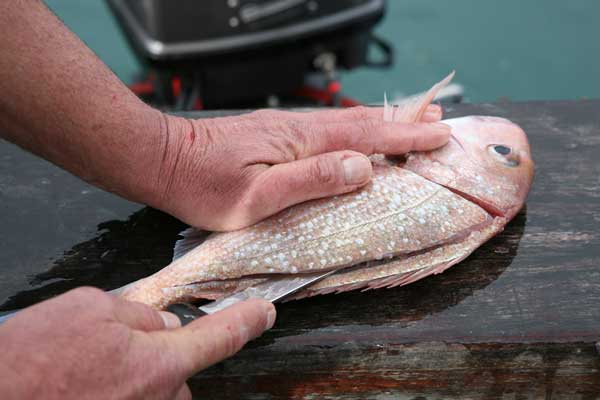Fish guts don’t sound very sexy. They’re innards and organs and…you know, they look a bit funny. But, as customers explore a newfound adventurous side to their dining habits, menus across the UK are beginning to feature these uncommon delicacies, Ben Winstanley writes for The Telegraph.
The rise to prominence of nose-to-tail cookery didn’t extend to fish until recently. Pioneered by Fergus Henderson, Britons have discovered a common sense approach to cooking that generates less waste and shows respect for the whole animal.
The problem is, Britain is proudly the land of les rosbifs — we are countryside lovers, happiest on land and in the pub. On our plates you will find meat and two veg because, despite being an island nation, we remain predominantly meat lovers. Our relationship with fish, on the other hand, is rather fussy.
Whether it’s squeamishness or supermarket availability, much of the UK’s supplies of seafood remain under-utilised. The UK fishing industry lands 624,000 tonnes of fish each year, yet most of what we catch is exported to Europe or, worse, battered and thrown in the frier: 382 million portions annually, according to the Federation of Fish Friers.
The fifty per-cent of us who do eat fish weekly are wedded to filets of firm favourites: cod, haddock and salmon. Elsewhere in the world, any and every part of the animal becomes a potential meal resulting in drastically lower food wastage.
Fish heads, often discarded in this country (to avoid staring our dinner in the eyes), are the basis of many popular southeast Asian curries and are gladly thrown into stockpots the world over. Bones, too, are extremely flexible in their usage. Deep-fried, they give a satisfying crunch to many dishes, while used in stock they release collagen to give a velvety consistency to liquids. Scallops, frequently trimmed down to their sweet white flesh, contain vast flavour in their cast off roes and frills. The roes add depth to sauces whereas the frills can be dried and used for seasoning.
The grizzlier stuff in the eyes of Brits is held in especially high regard by many cuisines. Monkfish livers are heralded as the 'foie gras of the ocean' due to their high fat content and rich marine flavour. Pan fried and served with pickle or sweet and sour, they are a simple delicacy. Salt cured tuna or mullet roe (botarga) offer a salinity as complex as the finest ham, wonderful shaved over pasta. Other fish roes beget an enjoyable fishiness in dips such as popular Greek and Turkish summer favourite taramasalata, literally translated as ‘fish roe salad’.
Read more HERE.
The rise to prominence of nose-to-tail cookery didn’t extend to fish until recently. Pioneered by Fergus Henderson, Britons have discovered a common sense approach to cooking that generates less waste and shows respect for the whole animal.
The problem is, Britain is proudly the land of les rosbifs — we are countryside lovers, happiest on land and in the pub. On our plates you will find meat and two veg because, despite being an island nation, we remain predominantly meat lovers. Our relationship with fish, on the other hand, is rather fussy.
Whether it’s squeamishness or supermarket availability, much of the UK’s supplies of seafood remain under-utilised. The UK fishing industry lands 624,000 tonnes of fish each year, yet most of what we catch is exported to Europe or, worse, battered and thrown in the frier: 382 million portions annually, according to the Federation of Fish Friers.
The fifty per-cent of us who do eat fish weekly are wedded to filets of firm favourites: cod, haddock and salmon. Elsewhere in the world, any and every part of the animal becomes a potential meal resulting in drastically lower food wastage.
Fish heads, often discarded in this country (to avoid staring our dinner in the eyes), are the basis of many popular southeast Asian curries and are gladly thrown into stockpots the world over. Bones, too, are extremely flexible in their usage. Deep-fried, they give a satisfying crunch to many dishes, while used in stock they release collagen to give a velvety consistency to liquids. Scallops, frequently trimmed down to their sweet white flesh, contain vast flavour in their cast off roes and frills. The roes add depth to sauces whereas the frills can be dried and used for seasoning.
The grizzlier stuff in the eyes of Brits is held in especially high regard by many cuisines. Monkfish livers are heralded as the 'foie gras of the ocean' due to their high fat content and rich marine flavour. Pan fried and served with pickle or sweet and sour, they are a simple delicacy. Salt cured tuna or mullet roe (botarga) offer a salinity as complex as the finest ham, wonderful shaved over pasta. Other fish roes beget an enjoyable fishiness in dips such as popular Greek and Turkish summer favourite taramasalata, literally translated as ‘fish roe salad’.
Read more HERE.
The Aquaculturists
This blog is maintained by The Aquaculturists staff and is supported by the
magazine International Aquafeed which is published by Perendale Publishers Ltd
For additional daily news from aquaculture around the world: aquaculture-news


No comments:
Post a Comment